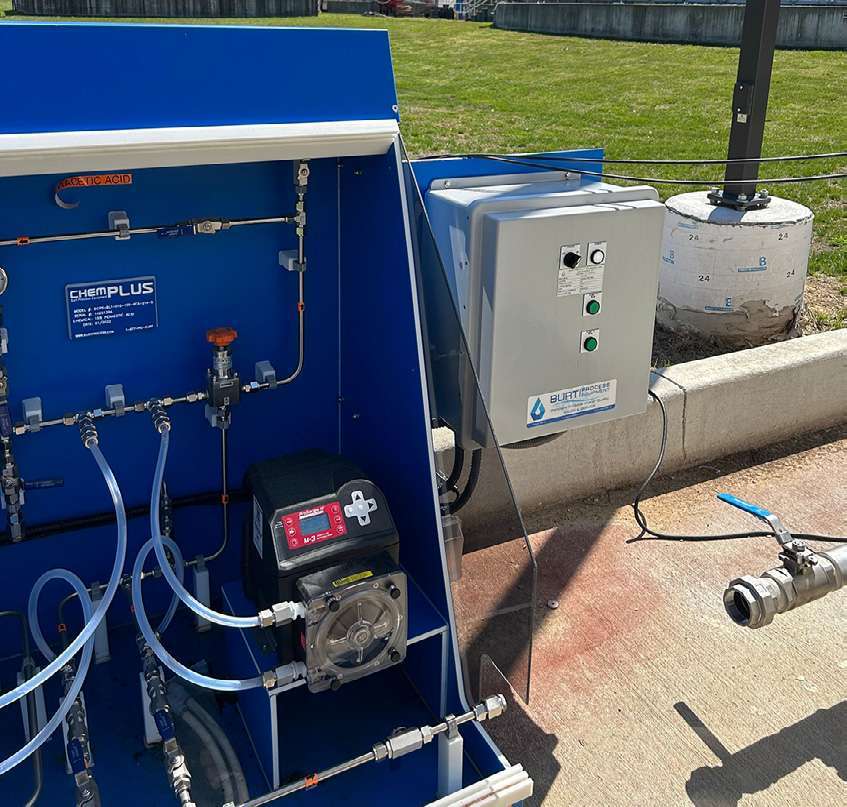Wastewater Treatment Plant Makes a Successful Switch from UV to PAA to Disinfect Effluent
SD1 Western Regional Wastewater Treatment Plant is located on the Ohio River in heavily industrialized Northern Kentucky. The plant’s primary function is to disinfect both municipal and industrial wastewater prior to introducing the water back into the Ohio River.
The Problem
The plant had been using a UV System to disinfect their effluent, and although it is in good working order, issues arose due to the industrial loading.
The plant gets heavy industrial flow containing a significant number of contaminants and the UV System was simply unable to reliably meet mandated disinfection requirements.
The Solution
Dave Koetting, the Plant Manager, contacted Pelton Environmental Products about peracetic acid and Blue-White® Metering pumps. Pelton partnered with Ohio Valley Service Solutions, located in Cambridge, Ohio to provide complete installation services of the system.
Ohio Valley Service Solutions provides field service, preventative maintenance, and turnkey installation for process, chemical feed, and rotating equipment to municipal and industrial customers throughout Ohio, Kentucky, and Indiana. OVSS prides themselves on understanding the needs of its customers and providing them with a solution that meets their expectations, ensures the safety of everyone involved, and fosters long term, trusting relationships.
Because the UV System could not adequately meet the disinfection needs, the Ohio Valley technician opted to make the switch to a chemical treatment solution, and installed a Duplex Skid System equipped with two Blue-White® FLEXFLO® M3 Peristaltic Metering Pumps.
The chemical chosen to deliver reliable disinfection of the wastewater is Peracetic Acid (PAA) at 15% solution under minimal pressure.
PAA is an organic chemical made by combining acetic acid with hydrogen peroxide using a catalyst. It has a vinegar-like odor and is typically sold in a solution of acetic acid, peroxide, and water. PAA was first used as a disinfectant in the early 1900s and was registered as a disinfectant with the U.S. EPA in 1985.
Some Benefits of PAA include the fact it is environmentally friendly. When it oxidizes, PAA breaks down into acetic acid, water, and oxygen. This makes it safer to use on effluent that is discharged into source water or other bodies with high levels of organic content. PAA oxidizes almost instantly, so there is rarely any residual chemical after discharge.
For now, there are few regulations that affect the use of PAA, as it breaks down quickly and does not form any known DBPs.
Long shelf life. PAA has an estimated shelf life of six months to two years. One issue with PAA is that it is an off-gassing chemical, this is why a peristaltic pump makes an excellent choice, there are no valves to clog. The FLEXFLO M3 experiences no vapor lock and no loss of prime when dosing PAA.
Another benefit of the M3 is the pump’s broad turn down range and 4-20mA adjustment. These are important considerations because the plant will eventually changeover all systems from UV disinfection to chemical disinfection, and they have chosen to standardize on one chemical feed solution, the FLEXFLO M3 Peristaltic Metering Pump. The pump’s 10,000:1 turn down range means it will easily and successfully meet a broad spectrum of feed rate requirements.
Maintenance and spare sparts inventory are also a consideration. M3 requires very little regular maintenance, just periodic pump tube changes, and the simplicity of changing the M3’s pump tube factored into Ohio Valley’s decision to choose this particular peristaltic pump. Spare tube assemblies are the only parts inventory needed.chlorine in the system.
Result
Since the switch to a Duplex Skid System featuring the FLEXFLO M3 Peristaltic Metering Pumps, SD1 is experiencing reliable disinfection of wastewater and meeting all disinfection requirements.
This article originally appeared on Blue-White.com.
Gallery

